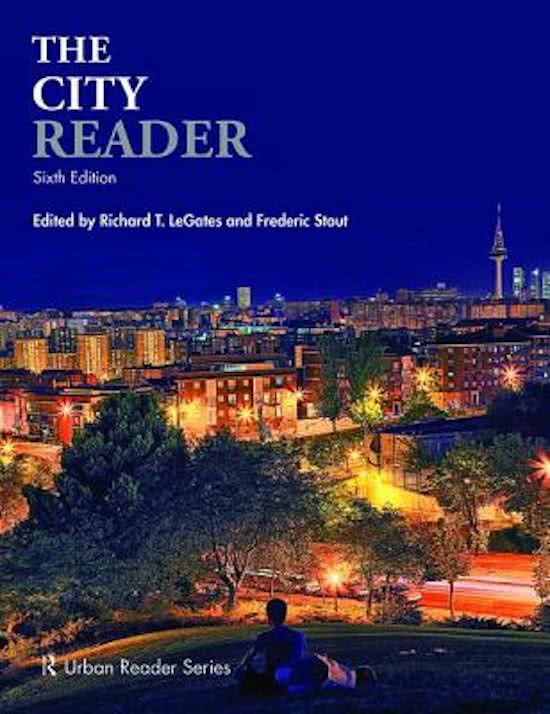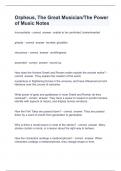Lecture 30/09 The death of the urban
In the 60’s and 70’s the Dutch cities centres began to drain, planning interventions prevented this from getting
critical. They tended to make the city centre more attractive. To prevent the ‘Detroit’ effect where the wealthy
middle class left the centre and moved to suburbs.
The functional city was built around the use of the car
From functionality to liveability
Functionality might attribute to liveability but it’s not the same, nor are it opposites.
Some functional elements are necessary to make a neighbourhood liveable
Still today the ‘’liveable’’ cities have functional elements to it.
Functionality related to malleability, the idea that the government and all planning involved with the
government and the designers of the blueprints that they decided how society should look like, and what the
best solution was for that particular place.
After WWII the functional city got a lot of criticism from people like Jane Jacobs, they wanted to keep or make
the cities more liveable, and to not only take the blueprint/scientific/functional into account.
Core issues on the functional city
Functionality is not always attractive if people had a choice they did not want to live in high-rise
buildings
Policies did not always work out as expected: the world was less easy to command and control.
Other priorities emerged: nature, environment, social, recreation, heritage, etc.
Picture of subway station in Belgium
Planned and built in the 70’s. Planner thought by implementing a subway station it would bring economic
development and attract more people. However, this did not happen. This shows that planners used scientific
data and predicted the future on this, but this simply this not happen. This shows that just the ‘blueprint’
method or just to collect data does not always work.
End of the functional city
1959 end of CIAM
1960 societal changes (more wealth, car access, more free-time)
- people wanted more space, more recreational spaces. this led to sub-urbanisation
1970 the urban crisis starts
1970 &1980 response
The end of the functional city did not latterly mean that we stopped the functional city, we just stopped
believing it to be the ideal concept. There are still elements of the functional city that are important.
Functional to liveable
Functionality:
Separation of functions (office area’s and residential area’s)
Space for traffic
Cheap and rational building blocks
Neighbourhood idea (to mimic village life, gemeinschaft)
Liveable:
Mix functions (to create activity during the whole day)
Traffic only where wanted (Groningen city centre banned use of personal cars)
Attractive and varied (not only high-rise, but more diversity (bit of green, different heights in
buildings) this will result in people to feel more comfortable and at home.
Networks of contacts social networks are not dependent on where you lived
Perception and identity being able to identify neighbourhoods by for example landmarks etc. that
you know where you are.
,This introduced the idea of different building concepts:
Single family homes
Green areas ‘Green open cities’
Bike, walk, live, play
End of high-rise building around green
The introduction of the ‘residential yard’ or so called ‘woonerf’ the idea that everyone has priority over the
car. The car has to stop for everyone and everything. The concepts allows people to enjoy the street without
being disturbed by the car.
Back to the human scale, the big modernistic buildings were very big and made people feel small.
Also with the use of the car, walking around going from store to store, without using the car, this reflects back
to the human scale as well.
Transition neighbourhood combination of functional and liveable where people would use to car to get there
and leave, but not to go through. So people do usually used a car to get there but not to move themselves
within the neighbourhood. There is also a combination of green and high-rise.
Cauliflower district – 1970-1980
More green, less cars
Safe for kids on the streets
Made to discourage the use of cars.
Cauliflower to forced, a bit fake, made as in a lab.
Three problems to the cauliflower
1. No idea how to get out (labyrinth), you get easily lost
2. No identity, no clue where it is located, could be Amsterdam, Leeuwarden, or Groningen
3. Difficult to navigate, there is no centre in the neighbourhood, no way of orientation.
Still based on ‘garden city’
Still based on neighbourhood idea
Still based on the planners and designers as expert (they still thought they knew what the people
wanted)
Main takeaways functional to liveable
Listen to people and understand how people want to live
Try to make area’s attractive and liveable
There was an acceptance that the planners and designers had to listen to the people
Urban renewal
Improving instead of demolishing
Overall intentions were to improve the housing quality. This urban renewal process became a cultural and
social activity in which the planner involved himself, but he became more a supportive role and listened more
to the residents.
Gentrification a process where rich people move to the city centre and therefor the neighbourhood improved
since more money came in. This resulted in the houses prices going up, because of this the ‘’poor’’ that used to
live here where somewhat forced out.
Urban crisis:
City centre lost population
Economy and services in cities declined (shops closed, schools closed)
Centre of the city became less attractive
Poor people concentrating in centre and wealthier people moving out
Increase in commuting traffic due to suburbanisation
People moved back into the city centre due to the compact city policy! this is why the NL is one of the most
dense countries in the world.
Main principles from Compact city
, Stop and reverse population decline within cities
End the ‘spreading’ to begin ‘concentrating’ in urban area
Strong linkage urban development with public transport so people would use public transport and
mostly live closer to work.
City centre formation (city centre as a core or urban development)
Make the centre a place to make and spend money (variety in use of space)
Offices outside the ‘’old centre’’
Old city centre more a socio-cultural forum
Plans to demotivate the use of cars and motivate the use of the bike. (in Groningen, make it impossible to beat
the bike in speed)
Lecture 2/10 Clash of Giants
The Chicago school (internal) vs the Los Angeles school (external), the similarities and differences between
both.
The Chicago school
Was mainly influential in the industrialized cities 1920s-1950s
Two things we owe to them today:
The concentric circle model, diagram to analyse/compare cities. (explanatory power)
- you can apply the model (that was built upon Chicago) to other cities, and reflect upon them how
they did not fit the model. This way there was a benchmark to look how these cities developed.
Urbanism a way life urban sociology as a discipline
Logic behind Chicago school:
Central business district drives the development of the city, industrial locations were built around
the already existing city
The more space there was in for example between the central business district and the suburban area as
shown in the concentric circle model, the more the central business district was vulnerable to ‘dying out’
(death of the urban) due to the factor that are pulled towards the suburbs.
In the European cities this works the other way around, when the suburban area around the centre is larger,
there are more people drawn to the amenities within the city centre. This is due to one important fact, the
European cities could not/ would not, plan their cities centres to accommodate for the automobile such as the
American cities could.
Chicago model compared with the growth of a tree trunk. When the tree has a good year the growth ring is
large, when a city has a good/wealthy years for example the industrial expansion ring is large.
Logic behind Chicago school:
Chicago school focusses on what happens within the cities rather than between cities.
Industrial cities
Also immigrant wise, but then rather on how these immigrants influenced the city, china town, little
Italy for example.
Chicago school used metaphors from the animal kingdom, such as the invasion of ‘new species’(immigrants)
that changes the city and we change them in return.
Hoyt made a different version of the Chicago model. It was not anymore a nice and round circle, now it was
more sectors. It was a layer on the original one (industrial layer) that was caused by roads and the automobile.
Hoyt said that the parts around these developed infrastructural sectors would be more developed than other
parts of the city, and usually faster. More real estate based, real estate had more power. String street
development.
In the 60’s and 70’s the Dutch cities centres began to drain, planning interventions prevented this from getting
critical. They tended to make the city centre more attractive. To prevent the ‘Detroit’ effect where the wealthy
middle class left the centre and moved to suburbs.
The functional city was built around the use of the car
From functionality to liveability
Functionality might attribute to liveability but it’s not the same, nor are it opposites.
Some functional elements are necessary to make a neighbourhood liveable
Still today the ‘’liveable’’ cities have functional elements to it.
Functionality related to malleability, the idea that the government and all planning involved with the
government and the designers of the blueprints that they decided how society should look like, and what the
best solution was for that particular place.
After WWII the functional city got a lot of criticism from people like Jane Jacobs, they wanted to keep or make
the cities more liveable, and to not only take the blueprint/scientific/functional into account.
Core issues on the functional city
Functionality is not always attractive if people had a choice they did not want to live in high-rise
buildings
Policies did not always work out as expected: the world was less easy to command and control.
Other priorities emerged: nature, environment, social, recreation, heritage, etc.
Picture of subway station in Belgium
Planned and built in the 70’s. Planner thought by implementing a subway station it would bring economic
development and attract more people. However, this did not happen. This shows that planners used scientific
data and predicted the future on this, but this simply this not happen. This shows that just the ‘blueprint’
method or just to collect data does not always work.
End of the functional city
1959 end of CIAM
1960 societal changes (more wealth, car access, more free-time)
- people wanted more space, more recreational spaces. this led to sub-urbanisation
1970 the urban crisis starts
1970 &1980 response
The end of the functional city did not latterly mean that we stopped the functional city, we just stopped
believing it to be the ideal concept. There are still elements of the functional city that are important.
Functional to liveable
Functionality:
Separation of functions (office area’s and residential area’s)
Space for traffic
Cheap and rational building blocks
Neighbourhood idea (to mimic village life, gemeinschaft)
Liveable:
Mix functions (to create activity during the whole day)
Traffic only where wanted (Groningen city centre banned use of personal cars)
Attractive and varied (not only high-rise, but more diversity (bit of green, different heights in
buildings) this will result in people to feel more comfortable and at home.
Networks of contacts social networks are not dependent on where you lived
Perception and identity being able to identify neighbourhoods by for example landmarks etc. that
you know where you are.
,This introduced the idea of different building concepts:
Single family homes
Green areas ‘Green open cities’
Bike, walk, live, play
End of high-rise building around green
The introduction of the ‘residential yard’ or so called ‘woonerf’ the idea that everyone has priority over the
car. The car has to stop for everyone and everything. The concepts allows people to enjoy the street without
being disturbed by the car.
Back to the human scale, the big modernistic buildings were very big and made people feel small.
Also with the use of the car, walking around going from store to store, without using the car, this reflects back
to the human scale as well.
Transition neighbourhood combination of functional and liveable where people would use to car to get there
and leave, but not to go through. So people do usually used a car to get there but not to move themselves
within the neighbourhood. There is also a combination of green and high-rise.
Cauliflower district – 1970-1980
More green, less cars
Safe for kids on the streets
Made to discourage the use of cars.
Cauliflower to forced, a bit fake, made as in a lab.
Three problems to the cauliflower
1. No idea how to get out (labyrinth), you get easily lost
2. No identity, no clue where it is located, could be Amsterdam, Leeuwarden, or Groningen
3. Difficult to navigate, there is no centre in the neighbourhood, no way of orientation.
Still based on ‘garden city’
Still based on neighbourhood idea
Still based on the planners and designers as expert (they still thought they knew what the people
wanted)
Main takeaways functional to liveable
Listen to people and understand how people want to live
Try to make area’s attractive and liveable
There was an acceptance that the planners and designers had to listen to the people
Urban renewal
Improving instead of demolishing
Overall intentions were to improve the housing quality. This urban renewal process became a cultural and
social activity in which the planner involved himself, but he became more a supportive role and listened more
to the residents.
Gentrification a process where rich people move to the city centre and therefor the neighbourhood improved
since more money came in. This resulted in the houses prices going up, because of this the ‘’poor’’ that used to
live here where somewhat forced out.
Urban crisis:
City centre lost population
Economy and services in cities declined (shops closed, schools closed)
Centre of the city became less attractive
Poor people concentrating in centre and wealthier people moving out
Increase in commuting traffic due to suburbanisation
People moved back into the city centre due to the compact city policy! this is why the NL is one of the most
dense countries in the world.
Main principles from Compact city
, Stop and reverse population decline within cities
End the ‘spreading’ to begin ‘concentrating’ in urban area
Strong linkage urban development with public transport so people would use public transport and
mostly live closer to work.
City centre formation (city centre as a core or urban development)
Make the centre a place to make and spend money (variety in use of space)
Offices outside the ‘’old centre’’
Old city centre more a socio-cultural forum
Plans to demotivate the use of cars and motivate the use of the bike. (in Groningen, make it impossible to beat
the bike in speed)
Lecture 2/10 Clash of Giants
The Chicago school (internal) vs the Los Angeles school (external), the similarities and differences between
both.
The Chicago school
Was mainly influential in the industrialized cities 1920s-1950s
Two things we owe to them today:
The concentric circle model, diagram to analyse/compare cities. (explanatory power)
- you can apply the model (that was built upon Chicago) to other cities, and reflect upon them how
they did not fit the model. This way there was a benchmark to look how these cities developed.
Urbanism a way life urban sociology as a discipline
Logic behind Chicago school:
Central business district drives the development of the city, industrial locations were built around
the already existing city
The more space there was in for example between the central business district and the suburban area as
shown in the concentric circle model, the more the central business district was vulnerable to ‘dying out’
(death of the urban) due to the factor that are pulled towards the suburbs.
In the European cities this works the other way around, when the suburban area around the centre is larger,
there are more people drawn to the amenities within the city centre. This is due to one important fact, the
European cities could not/ would not, plan their cities centres to accommodate for the automobile such as the
American cities could.
Chicago model compared with the growth of a tree trunk. When the tree has a good year the growth ring is
large, when a city has a good/wealthy years for example the industrial expansion ring is large.
Logic behind Chicago school:
Chicago school focusses on what happens within the cities rather than between cities.
Industrial cities
Also immigrant wise, but then rather on how these immigrants influenced the city, china town, little
Italy for example.
Chicago school used metaphors from the animal kingdom, such as the invasion of ‘new species’(immigrants)
that changes the city and we change them in return.
Hoyt made a different version of the Chicago model. It was not anymore a nice and round circle, now it was
more sectors. It was a layer on the original one (industrial layer) that was caused by roads and the automobile.
Hoyt said that the parts around these developed infrastructural sectors would be more developed than other
parts of the city, and usually faster. More real estate based, real estate had more power. String street
development.





